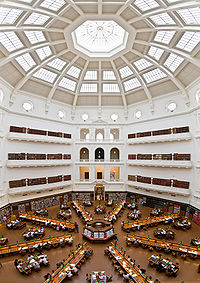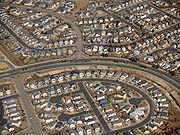
Built environment
Encyclopedia

Neighbourhood
A neighbourhood or neighborhood is a geographically localised community within a larger city, town or suburb. Neighbourhoods are often social communities with considerable face-to-face interaction among members. "Researchers have not agreed on an exact definition...
and cities
City
A city is a relatively large and permanent settlement. Although there is no agreement on how a city is distinguished from a town within general English language meanings, many cities have a particular administrative, legal, or historical status based on local law.For example, in the U.S...
that can often include their supporting infrastructure
Infrastructure
Infrastructure is basic physical and organizational structures needed for the operation of a society or enterprise, or the services and facilities necessary for an economy to function...
, such as water supply
Water supply
Water supply is the provision of water by public utilities, commercial organisations, community endeavours or by individuals, usually via a system of pumps and pipes...
or energy networks
Electric power distribution
File:Electricity grid simple- North America.svg|thumb|380px|right|Simplified diagram of AC electricity distribution from generation stations to consumers...
.The built environment is a material, spatial and cultural product of human labor that combines physical elements and energy in forms necessary for living, working and playing.
In practice, the term is typically used to describe the interdisciplinary field which addresses the design
Design
Design as a noun informally refers to a plan or convention for the construction of an object or a system while “to design” refers to making this plan...
, construction
Construction
In the fields of architecture and civil engineering, construction is a process that consists of the building or assembling of infrastructure. Far from being a single activity, large scale construction is a feat of human multitasking...
, management and use of these man-made surroundings as an interrelated whole as well as their relationship to human activities over time (rather than a particular element in isolation or at a single moment in time). The field is generally not regarded as a traditional profession or academic discipline in its own right, instead drawing upon areas such as economics
Economics
Economics is the social science that analyzes the production, distribution, and consumption of goods and services. The term economics comes from the Ancient Greek from + , hence "rules of the house"...
, law
Law
Law is a system of rules and guidelines which are enforced through social institutions to govern behavior, wherever possible. It shapes politics, economics and society in numerous ways and serves as a social mediator of relations between people. Contract law regulates everything from buying a bus...
, public policy
Public policy
Public policy as government action is generally the principled guide to action taken by the administrative or executive branches of the state with regard to a class of issues in a manner consistent with law and institutional customs. In general, the foundation is the pertinent national and...
, management, design
Design
Design as a noun informally refers to a plan or convention for the construction of an object or a system while “to design” refers to making this plan...
, technology
Technology
Technology is the making, usage, and knowledge of tools, machines, techniques, crafts, systems or methods of organization in order to solve a problem or perform a specific function. It can also refer to the collection of such tools, machinery, and procedures. The word technology comes ;...
, and environmental sustainability.
Architecture & Environmental Psychology
In architectureArchitecture
Architecture is both the process and product of planning, designing and construction. Architectural works, in the material form of buildings, are often perceived as cultural and political symbols and as works of art...
and environmental psychology
Environmental psychology
Environmental psychology is an interdisciplinary field focused on the interplay between humans and their surroundings. The field defines the term environment broadly, encompassing natural environments, social settings, built environments, learning environments, and informational environments...
, the phrase is a useful acknowledgment that the majority of urban environments already exist, that a small fraction of buildings constructed annually, even in the industrialized world, are designed by architects, and that users of the built environment encounter issues that cross the traditional professional boundaries between urban planners, traffic engineers
Traffic engineering (transportation)
For the engineering of communications and computer networks, see Teletraffic engineering.Traffic engineering is a branch of civil engineering that uses engineering techniques to achieve the safe and efficient movement of people and goods on roadways...
, zoning
Zoning
Zoning is a device of land use planning used by local governments in most developed countries. The word is derived from the practice of designating permitted uses of land based on mapped zones which separate one set of land uses from another...
authorities, architects, interior designers, industrial designers, etc.
Landscape Architecture
In landscape architectureLandscape architecture
Landscape architecture is the design of outdoor and public spaces to achieve environmental, socio-behavioral, or aesthetic outcomes. It involves the systematic investigation of existing social, ecological, and geological conditions and processes in the landscape, and the design of interventions...
, the built environment is identified as man-made landscapes as opposed to the natural environment
Natural environment
The natural environment encompasses all living and non-living things occurring naturally on Earth or some region thereof. It is an environment that encompasses the interaction of all living species....
. For example, Central Park
Central Park
Central Park is a public park in the center of Manhattan in New York City, United States. The park initially opened in 1857, on of city-owned land. In 1858, Frederick Law Olmsted and Calvert Vaux won a design competition to improve and expand the park with a plan they entitled the Greensward Plan...
in New York City
New York City
New York is the most populous city in the United States and the center of the New York Metropolitan Area, one of the most populous metropolitan areas in the world. New York exerts a significant impact upon global commerce, finance, media, art, fashion, research, technology, education, and...
may have the look, feel and quality of natural surroundings, but is completely man-made and 'built'.
Urban Planning
In urban planningUrban planning
Urban planning incorporates areas such as economics, design, ecology, sociology, geography, law, political science, and statistics to guide and ensure the orderly development of settlements and communities....
, the phrase connotes the idea that a large percentage of the human environment is man-made, and these artificial surroundings are so extensive and cohesive that they function as organism
Organism
In biology, an organism is any contiguous living system . In at least some form, all organisms are capable of response to stimuli, reproduction, growth and development, and maintenance of homoeostasis as a stable whole.An organism may either be unicellular or, as in the case of humans, comprise...
s in the consumption of resources, disposal of wastes, and facilitation of productive enterprise within its bounds. Recently there has also been considerable dialogue and research into the built environment's impact on population health (see www.activelivingbydesign.org).

See also

- Anthropogenic metabolismAnthropogenic metabolism"Anthropogenic metabolism" is a term used in material flow analysis, substance flow analysis and waste management. It includes: "not only the physiological metabolism but also includes the thousands of goods and substances necessary to sustain modern life. Anthropogenic stands for man-made...
- ArchitectureArchitectureArchitecture is both the process and product of planning, designing and construction. Architectural works, in the material form of buildings, are often perceived as cultural and political symbols and as works of art...
- Center for the Built EnvironmentCenter for the Built EnvironmentThe Center for the Built Environment at the University of California, Berkeley is a National Science Foundation Industry/University Cooperative Research Center...
- City planning
- ConstructionConstructionIn the fields of architecture and civil engineering, construction is a process that consists of the building or assembling of infrastructure. Far from being a single activity, large scale construction is a feat of human multitasking...
- Cultural landscapeCultural landscapeCultural Landscapes have been defined by the World Heritage Committee as distinct geographical areas or properties uniquely "..represent[ing] the combined work of nature and of man.."....
- Environmental Design Research AssociationEnvironmental Design Research AssociationThe Environmental Design Research Association is an international, interdisciplinary organization founded in 1968 by design professionals, social scientists, students, educators, and facility managers...
- Environmental graphic designEnvironmental graphic designEnvironmental graphic design is a design profession embracing many design disciplines including graphic design, architecture, industrial design and landscape architecture...
- Environmental psychologyEnvironmental psychologyEnvironmental psychology is an interdisciplinary field focused on the interplay between humans and their surroundings. The field defines the term environment broadly, encompassing natural environments, social settings, built environments, learning environments, and informational environments...
- Environmental Sustainability
- Facilities Management
- Interior architectureInterior architectureInterior Architecture is truly a marriage of three distinct design disciplines: interior design, architecture, and industrial design...
- International Association of People-Environment StudiesInternational Association of People-Environment StudiesThe International Association of People-Environment Studies , has been promoting the interdisciplinary exchange of ideas between planning and social scientists for 35 years – above all between spatial planning, architecture, psychology, and sociology...
- LandscapeLandscapeLandscape comprises the visible features of an area of land, including the physical elements of landforms such as mountains, hills, water bodies such as rivers, lakes, ponds and the sea, living elements of land cover including indigenous vegetation, human elements including different forms of...
- Landscape architectureLandscape architectureLandscape architecture is the design of outdoor and public spaces to achieve environmental, socio-behavioral, or aesthetic outcomes. It involves the systematic investigation of existing social, ecological, and geological conditions and processes in the landscape, and the design of interventions...
- Natural environmentNatural environmentThe natural environment encompasses all living and non-living things occurring naturally on Earth or some region thereof. It is an environment that encompasses the interaction of all living species....
- Public PolicyPublic policyPublic policy as government action is generally the principled guide to action taken by the administrative or executive branches of the state with regard to a class of issues in a manner consistent with law and institutional customs. In general, the foundation is the pertinent national and...
- Sustainable DevelopmentSustainable developmentSustainable development is a pattern of resource use, that aims to meet human needs while preserving the environment so that these needs can be met not only in the present, but also for generations to come...
- UrbanismUrbanismBroadly, urbanism is a focus on cities and urban areas, their geography, economies, politics, social characteristics, as well as the effects on, and caused by, the built environment.-Philosophy:...
- Urban planningUrban planningUrban planning incorporates areas such as economics, design, ecology, sociology, geography, law, political science, and statistics to guide and ensure the orderly development of settlements and communities....
- Vernacular architectureVernacular architectureVernacular architecture is a term used to categorize methods of construction which use locally available resources and traditions to address local needs and circumstances. Vernacular architecture tends to evolve over time to reflect the environmental, cultural and historical context in which it...
- Children Youth and Environments JournalChildren Youth and Environments JournalChildren, Youth and Environments is a peer-reviewed academic journal that publishes research articles, in-depth analyses, cutting-edge field reports, and critical book reviews on research, policy, and practice concerning inclusive and sustainable environments for children and youth worldwide.From...
Further reading
- Jeb Brugmann, Welcome to the urban revolution: how cities are changing the world, Bloomsbury Press, 2009
- Jane Jacobs, The Death and Life of Great American Cities, Random House, New York, 1961The Death and Life of Great American CitiesThe Death and Life of Great American Cities, by Jane Jacobs, is a greatly influential book on the subject of urban planning in the 20th century...
- Andrew Knight & Les Ruddock, Advanced Research Methods in the Built Environment, Wiley-Blackwell 2008
- Paul Chynoweth, The Built Environment Interdiscipline: A Theoretical Model for Decision Makers in Research and Teaching, Proceedings of the CIB Working Commission (W089) Building Education and Research Conference, Kowloon Sangri-La Hotel, Hong Kong, 10 - 13 April 2006.

